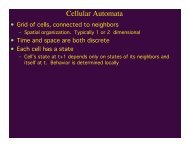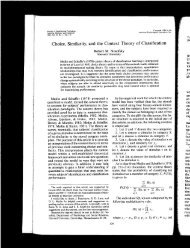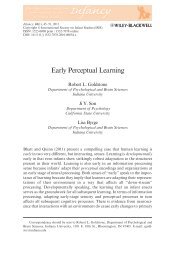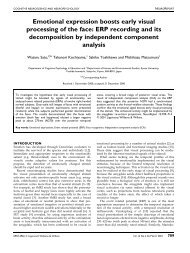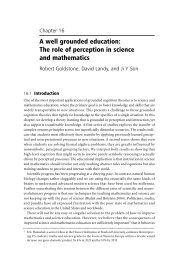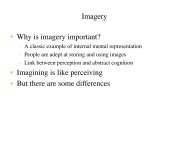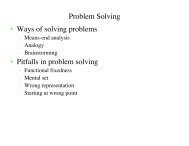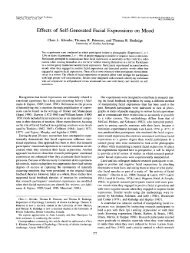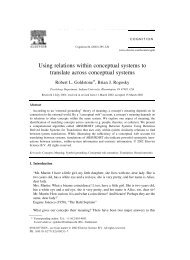the psychology of learning and motivation - Percepts and Concepts ...
the psychology of learning and motivation - Percepts and Concepts ...
the psychology of learning and motivation - Percepts and Concepts ...
You also want an ePaper? Increase the reach of your titles
YUMPU automatically turns print PDFs into web optimized ePapers that Google loves.
48 John Swellerreproduction results in a logical structure ensuring that each generation isnecessarily different from <strong>the</strong> previous generation. Sexual reproductionoccurs in order to ensure that, unlike <strong>the</strong> case <strong>of</strong> asexual reproduction,generational variation is a logical necessity <strong>of</strong> <strong>the</strong> procedure. Duringsexual reproduction, information is obtained <strong>and</strong> combined from bothmale <strong>and</strong> female parents resulting in <strong>of</strong>fspring that necessarily differ fromei<strong>the</strong>r parent. Information is not only borrowed, it is also reorganized.The acquisition <strong>and</strong> storage <strong>of</strong> information in long-term memorymore closely resembles sexual than asexual reproduction. We rarelyremember information with minimal or no change in <strong>the</strong> same way asasexual reproduction or as an electronic recording device ‘‘remember’’information. We do acquire or borrow <strong>the</strong> vast bulk <strong>of</strong> <strong>the</strong> informationheld in long-term memory from o<strong>the</strong>r people, but we alter that informationdepending on what we have already stored in long-term memory.The processes by which we borrow information from o<strong>the</strong>rs are wellknown. We imitate o<strong>the</strong>r people (B<strong>and</strong>ura, 1986), listen to what o<strong>the</strong>rstell us, read what <strong>the</strong>y write, <strong>and</strong> look at diagrams <strong>and</strong> pictures that <strong>the</strong>yproduce. Listening, reading, <strong>and</strong> looking at diagrams <strong>and</strong> pictures areparticularly important in <strong>the</strong> acquisition <strong>of</strong> <strong>the</strong> biologically secondaryinformation that is <strong>the</strong> subject <strong>of</strong> education <strong>and</strong> training. The vast bulk<strong>of</strong> <strong>the</strong> biologically secondary information that is stored in long-termmemory is acquired by one <strong>of</strong> <strong>the</strong> processes or a combination <strong>of</strong> <strong>the</strong>seprocesses.Although information is borrowed from o<strong>the</strong>rs, it is reorganized in amanner analogous to sexual reproduction. We combine new informationwith information already stored in long-term memory <strong>and</strong> it is <strong>the</strong> new,reorganized information that is stored ra<strong>the</strong>r than an exact copy <strong>of</strong> <strong>the</strong>information that was presented. In o<strong>the</strong>r words, we store information asschemas ra<strong>the</strong>r than as precise copies (Chi, Glaser, & Rees, 1982). Eachschema stored is likely to be different from <strong>the</strong> schema held in <strong>the</strong> longtermmemory <strong>of</strong> <strong>the</strong> person from whom it was borrowed because it is acombination <strong>of</strong> <strong>the</strong> borrowed information combined with informationalready held in long-term memory.Cognitive load <strong>the</strong>ory has been used to generate many instructionaleffects <strong>and</strong> <strong>the</strong>se effects rely heavily on <strong>the</strong> borrowing <strong>and</strong> reorganizingprinciple. The effects are largely concerned with techniques for presentinginformation to learners that are most likely to result in <strong>the</strong> facilitation <strong>of</strong>schema acquisition. In addition to <strong>the</strong> acquisition <strong>of</strong> schemas, cognitiveload <strong>the</strong>ory is also concerned with <strong>the</strong>ir automation so that <strong>the</strong>y can be usedwithout conscious processing in working memory (Kotovsky, Hayes, &Simon, 1985; Schneider & Shiffrin, 1977; Shiffrin & Schneider, 1977). In<strong>the</strong> case <strong>of</strong> schema acquisition, <strong>the</strong> <strong>the</strong>ory assumes that learners acquiredomain-specific information that is best obtained from o<strong>the</strong>r people. All<strong>the</strong> cognitive load instructional effects depend on <strong>the</strong>se assumptions.




